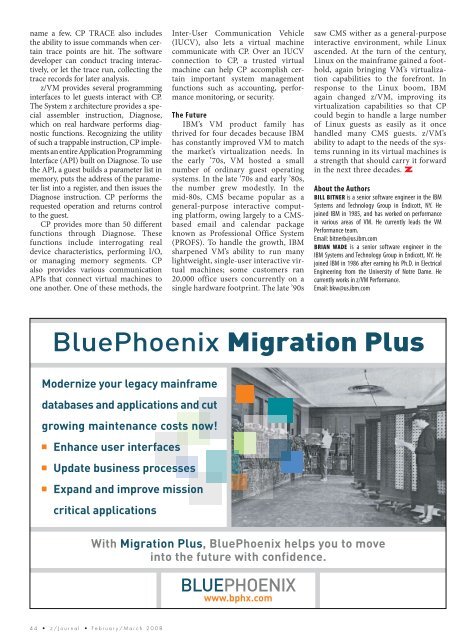VIrTuAL MACHINES - z/VM - IBM
VIrTuAL MACHINES - z/VM - IBM
VIrTuAL MACHINES - z/VM - IBM
Create successful ePaper yourself
Turn your PDF publications into a flip-book with our unique Google optimized e-Paper software.
name a few. CP TRACE also includesthe ability to issue commands when certaintrace points are hit. The softwaredeveloper can conduct tracing interactively,or let the trace run, collecting thetrace records for later analysis.z/<strong>VM</strong> provides several programminginterfaces to let guests interact with CP.The System z architecture provides a specialassembler instruction, Diagnose,which on real hardware performs diagnosticfunctions. Recognizing the utilityof such a trappable instruction, CP implementsan entire Application ProgrammingInterface (API) built on Diagnose. To usethe API, a guest builds a parameter list inmemory, puts the address of the parameterlist into a register, and then issues theDiagnose instruction. CP performs therequested operation and returns controlto the guest.CP provides more than 50 differentfunctions through Diagnose. Thesefunctions include interrogating realdevice characteristics, performing I/O,or managing memory segments. CPalso provides various communicationAPIs that connect virtual machines toone another. One of these methods, theInter-User Communication Vehicle(IUCV), also lets a virtual machinecommunicate with CP. Over an IUCVconnection to CP, a trusted virtualmachine can help CP accomplish certainimportant system managementfunctions such as accounting, performancemonitoring, or security.The Future<strong>IBM</strong>’s <strong>VM</strong> product family hasthrived for four decades because <strong>IBM</strong>has constantly improved <strong>VM</strong> to matchthe market’s virtualization needs. Inthe early ’70s, <strong>VM</strong> hosted a smallnumber of ordinary guest operatingsystems. In the late ’70s and early ’80s,the number grew modestly. In themid-80s, CMS became popular as ageneral-purpose interactive computingplatform, owing largely to a CMSbasedemail and calendar packageknown as Professional Office System(PROFS). To handle the growth, <strong>IBM</strong>sharpened <strong>VM</strong>’s ability to run manylightweight, single-user interactive virtualmachines; some customers ran20,000 office users concurrently on asingle hardware footprint. The late ’90ssaw CMS wither as a general-purposeinteractive environment, while Linuxascended. At the turn of the century,Linux on the mainframe gained a foothold,again bringing <strong>VM</strong>’s virtualizationcapabilities to the forefront. Inresponse to the Linux boom, <strong>IBM</strong>again changed z/<strong>VM</strong>, improving itsvirtualization capabilities so that CPcould begin to handle a large numberof Linux guests as easily as it oncehandled many CMS guests. z/<strong>VM</strong>’sability to adapt to the needs of the systemsrunning in its virtual machines isa strength that should carry it forwardin the next three decades. ZAbout the AuthorsBill Bitner is a senior software engineer in the <strong>IBM</strong>Systems and Technology Group in Endicott, NY. Hejoined <strong>IBM</strong> in 1985, and has worked on performancein various areas of <strong>VM</strong>. He currently leads the <strong>VM</strong>Performance team.Email: bitnerb@us.ibm.comBrian Wade is a senior software engineer in the<strong>IBM</strong> Systems and Technology Group in Endicott, NY. Hejoined <strong>IBM</strong> in 1986 after earning his Ph.D. in ElectricalEngineering from the University of Notre Dame. Hecurrently works in z/<strong>VM</strong> Performance.Email: bkw@us.ibm.comBluePhoenix Migration PlusModernize your legacy mainframedatabases and applications and cutgrowing maintenance costs now!Enhance user interfacesUpdate business processesExpand and improve missioncritical applicationsWith Migration Plus, BluePhoenix helps you to moveinto the future with confidence.BLUEPHOENIXwww.bphx.com4 4 • z / J o u r n a l • F e b r u a r y / M a r c h 2 0 0 8

















